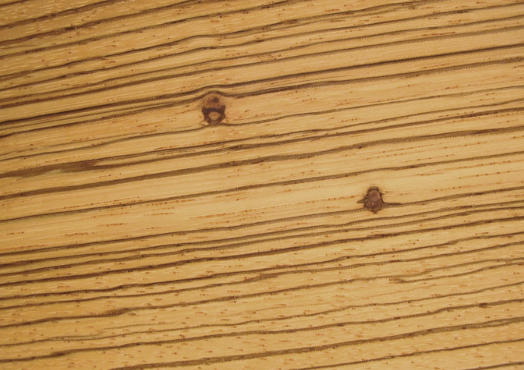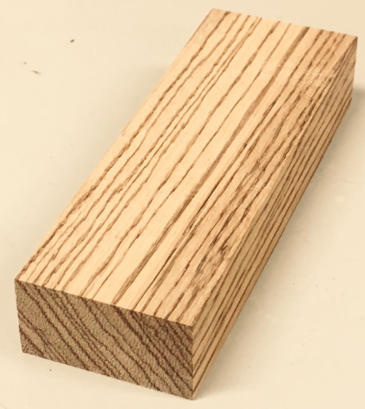Views: 222 Author: Rebecca Publish Time: 2025-10-15 Origin: Site











Content Menu
● The Origin and Material Character of Zebra Wood
● Energetic Frequency and Vibrational Healing Mechanisms
● Scientific and Health Considerations
● The Spiritual Symbolism of Zebra Wood
>> Key symbolic meanings associated with zebra wood:
● Sustainability and Ethical Perspectives
● Comparative Energetics: Zebra Wood vs. True Healing Woods
● The Energetic Paradox: Stability Without Rejuvenation
● Modern and Practical Uses of Zebra Wood
● Integrating Aesthetic Woods Responsibly in Wellness Design
● FAQs
>> 1. What makes zebra wood unique compared to other exotic woods?
>> 2. Is zebra wood safe for skin contact or body tools?
>> 3. Can zebra wood contribute to spiritual balance even if not for healing?
>> 4. Which types of wood are best for healing and energy flow?
>> 5. How can zebra wood be ethically sourced?
Zebra wood has long captivated the imagination of woodworkers, interior designers, and collectors for its remarkable striped pattern—a contrast of dark brown lines overlaying a creamy golden background, similar to the pelt of a zebra. Native primarily to Central and West Africa, this exotic hardwood (scientifically known as Microberlinia brazzavillensis) carries associations of luxury, craftsmanship, and endurance.
However, despite its stunning appearance and structural strength, zebra wood rarely appears in healing, spiritual, or metaphysical applications. Unlike aromatic and energetically resonant woods such as sandalwood, cedar, or rosewood, zebra wood is valued more for aesthetic stability than emotional or energetic transformation.
This article delves deeply into why zebra wood is not suitable for healing—from both scientific and energetic perspectives. We'll explore its physical characteristics, chemical components, vibrational limitations, sustainability concerns, and the cultural symbolism that defines its unique but non-healing nature.

Zebra wood primarily originates from countries like Gabon, Cameroon, and the Republic of Congo. The tree grows tall—sometimes surpassing 120 feet—with a dense, interlocked grain. On a physical level, zebra wood embodies structural resilience and visual contrast, symbolizing balance but not fluidity.
Its technical properties include:
- Janka hardness: Around 1,830 lbf, much denser than average hardwoods.
- Density: Roughly 50–56 lb/ft⊃3;, contributing to its heaviness and acoustic sharpness.
- Grain pattern: Strongly interlocked, producing wavy or ribbon-like lines.
- Workability: Challenging to cut or shape due to frequent interlocking and risk of tear-out.
These same mechanical properties that make zebra wood durable—and visually arresting—also result in energetic rigidity. In healing, flow and permeability are crucial, as energy needs channels to circulate. Zebra wood's dense grain structure and lack of aromatic resin make it energetically closed-off, unsuited to spiritual healing where frequency resonance matters.
In vibrational healing traditions, natural materials carry distinct subtle energy frequencies that affect emotional or spiritual states. Woods like sandalwood or palo santo are revered precisely because of their open cellular structures and volatile fragrance compounds, which transmit calming or purifying vibrations.
| Wood Type | Vibrational Quality | Energy Flow Characteristics | Common Healing Usage |
|---|---|---|---|
| Sandalwood | High resonance | Open and fluid | Used for peace, meditation, cleansing |
| Cedar | Grounded vibration | Purifying and protective | Used for aura shielding, renewal |
| Rosewood | Heart-centered vibration | Smooth and receptive | Used for emotional restoration |
| Zebra Wood | Fixed and dense vibration | Restrictive and grounding | Used for grounding, stability only |
Zebra wood's dense microstructure resists harmonic oscillation. It grounds energy downward instead of expanding or circulating it. This quality is ideal for anchoring meditation, but counterproductive for healing intentions, which rely on transmutation and energy release.
From a biochemical standpoint, zebra wood's physical and chemical composition further reduces its suitability for personal or healing contact.
1. Natural allergens: Zebra wood contains quinones and phenolic compounds that can cause allergic reactions in sensitive individuals. Symptoms may include dermatitis, nasal irritation, and eye sensitivity when dust is inhaled.
2. Lack of aroma: Healing woods often release aromatic oils with psychoactive benefits, helping regulate breathing, mood, and relaxation. Zebra wood is nearly odorless, offering no olfactory support in therapeutic sessions.
3. Tool contamination: The fine dust generated while cutting zebra wood can be irritating to mucous membranes. This toxicity makes it problematic for use in personal healing tools like pendulums, energy sticks, or chakra wands.
4. Thermal and energetic insulation: Its dense fiber structure acts like energetic insulation, limiting temperature and vibrational transfer during touch-based therapies.
From this view, zebra wood's inert nature, while beneficial for construction, ultimately blocks rather than channels energy, diminishing any therapeutic potential.
Symbolically, zebra wood represents duality, order, and discipline. The light and dark stripes symbolize the intertwining forces of yin and yang, stability and balance. This makes zebra wood spiritually significant to those seeking equilibrium and grounding during life transitions. However, healing—especially emotional or energetic healing—requires openness, catharsis, and receptivity.
- Balance and harmony between extremes.
- Protection against unstable emotional forces.
- Mental strength and self-discipline.
- Focus and determination in achieving goals.
These associations demonstrate why zebra wood is a stabilizing material but not a transmuting or purifying one. Its vibration reinforces boundaries rather than dissolving emotional blockages, which restricts its healing capacity.

An often-overlooked reason zebra wood should not be used in healing contexts lies in environmental ethics. Zebra wood is considered a vulnerable species under the IUCN Red List due to overexploitation for luxury products. Unsustainable harvesting has led to deforestation and habitat depletion in equatorial African rainforests.
Healers and spiritual practitioners frequently advocate harmony with nature, prioritizing ecological respect. Using zebra wood—often harvested unsustainably—contradicts the heart of that philosophy. Sustainable alternatives such as bamboo, sandalwood, or reclaimed wood are energetically cleaner and ethically aligned with the values of care and renewal inherent in healing work.
| Property | Zebra Wood | Sandalwood | Cedar | Rosewood |
|---|---|---|---|---|
| Density | High | Moderate | Medium | Medium |
| Aroma | None | Strong, calming | Earthy | Sweet, floral |
| Energy Flow | Restrictive | Free-flowing | Purifying | Heart-centered |
| Healing Application | Balance, focus | Spiritual clarity | Cleansing | Compassion |
| Sustainability | Vulnerable | Controlled harvesting | Abundant | Moderate |
Healing woods are characterized by aromatic molecular structures that facilitate emotional change through scent and vibration, while zebra wood's dense, scentless nature keeps it energetically inert. In essence, one connects—while the other contains.
One of zebra wood's paradoxical traits is its static energy. It holds energy rather than transmits it. This immobility makes it excellent for focus meditation but poor for practices requiring emotional release.
Healers describe zebra wood energy as “anchoring,” useful for practitioners who need to stay centered during chaotic spiritual experiences. However, in energy transfer or chakra healing, this anchored field can unintentionally block energy flow, preventing emotional decompression or spiritual cleansing.
Thus, zebra wood supports discipline rather than detoxification, structure rather than softness—qualities crucial in building the self but restrictive when seeking to heal or release.
Even though zebra wood is unsuitable for healing, it remains a valued asset in other creative and industrial domains.
- Luxury Furniture & Cabinetry: Its exotic veneer surface creates unique visual contrast for custom interiors.
- Musical Instruments: Frequently used for guitar backs and piano inlays, offering tonal depth and aesthetic richness.
- Automotive Accents: High-end car design occasionally features zebra wood panels to evoke uniqueness and prestige.
- Architectural Elements: Used as veneer wall panels or decorative flooring in contemporary architecture.
- Metaphysical Decor: Suitable for altars or grounding boards intended for balance, but not purification or healing.
These applications highlight zebra wood's excellence as a stabilizing visual and material presence, reinforcing grounding energy rather than promoting transformation.
Although zebra wood is not healing, it can play a complementary role in wellness environments if used thoughtfully. For example, combining zebra wood furniture with energetically active elements such as crystal quartz, cedar incense, or water features can create harmony between grounded stability and fluid flow.
In holistic architecture and spa design:
- Use zebra wood as accent material for calm, structured spaces.
- Integrate aromatic or porous woods nearby to restore energetic circulation.
- Employ zebra wood to create boundaries or zones within a room, symbolizing balance between activity and rest.
This approach mirrors the principle of yin-yang harmony—a balance between stillness (zebra wood) and movement (healing woods).
Zebra wood's stunning pattern, durability, and grounding essence make it a material of strength and discipline, but it lacks the qualities that define healing woods—resonance, vibration, and permeability. Its dense grain, absence of aroma, allergenic components, and restricted energy flow render it unsuitable for spiritual or therapeutic purposes. Instead, it embodies balance and endurance, qualities that stabilize but do not heal.
When seeking materials to support emotional recovery or spiritual advancement, one should turn to sandalwood, rosewood, or cedar, whose natural frequencies promote flow and release. Zebra wood reminds us that not all beauty serves as medicine—some, like this striking African hardwood, are built to teach stability, not transformation.

Zebra wood is renowned for its high contrast grain pattern resembling zebra stripes. Its interlocked texture and strength make it visually and structurally distinctive. However, these same traits restrict its suitability for energetic or healing uses.
Not entirely. Prolonged contact or exposure to zebra wood dust can cause mild allergic reactions. It's recommended to wear protective masks and gloves when working with it, especially during sanding or cutting.
Yes. It supports mental grounding and focus, helping practitioners maintain concentration and emotional balance, particularly during meditation or decision-making.
Highly recommended choices include sandalwood, cedar, palo santo, and rosewood. These woods are aromatic, spiritually receptive, and energetically vibrant, making them suitable for both physical and emotional healing.
Buy from FSC-certified suppliers who engage in replanting and fair-trade practices. Ethical sourcing supports the sustainability of African forests and ensures that the spiritual integrity of the material remains uncompromised.